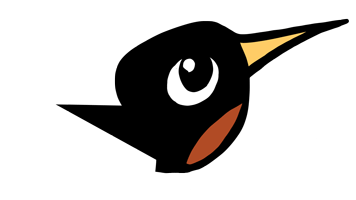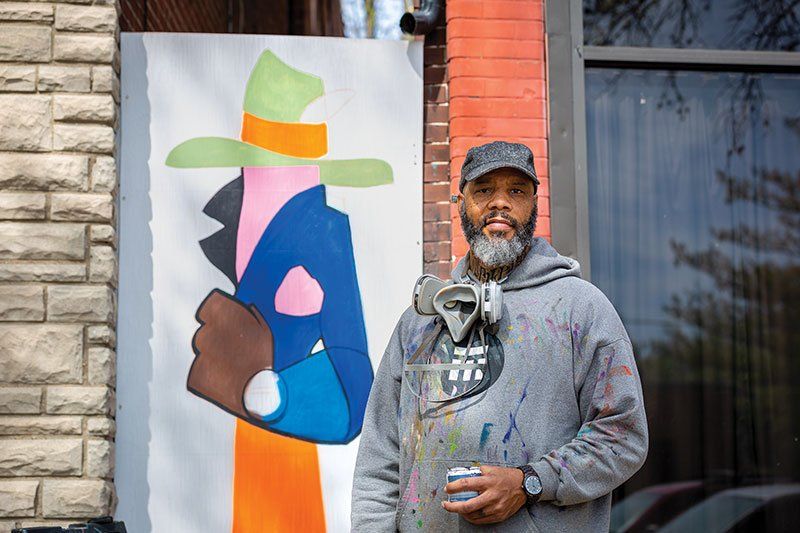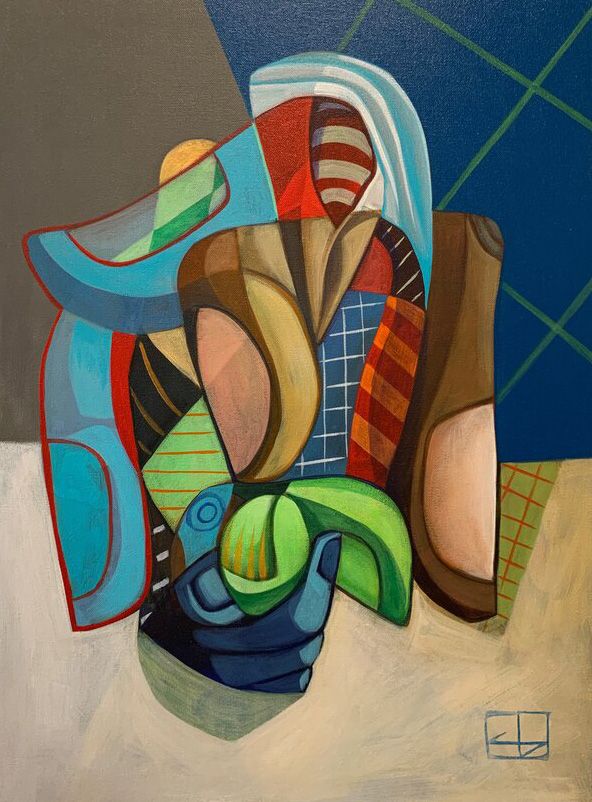Bayoc’s own hands are huge—so big that when the artist was growing up as a tall kid in O’Fallon, Illinois, folks assumed that he’d focus on basketball. Instead, he became consumed with visual art and majored in it at Grambling State University, in Louisiana.
At that time, he still went by his given name, Clifford Miskell Jr., but was signing his art C-Baby. One day in Swahili class, he noticed a name that began with “Cb” and from there came up with the acronym Cbabi (pronounced “kuh-BOB-ee,” it stands for “Creative Black Artist Battling Ignorance”). Not long after returning to St. Louis, in the mid-’90s, he met Reine Tart, whom he married. They chose a different acronym for their common last name, Bayoc: “Blessed African Youth of Creativity.” They now have three children; Reine is the proprietor of SweetArt, a vegan-friendly bakeshop and café in the Shaw neighborhood.
Early in Cbabi’s career, he worked as a caricature artist at Six Flags; then he became a regular illustrator for the magazine Rap Pages. Music has long been an inspiration for Bayoc and, sometimes, a marketing opportunity. One of his chalk drawings figured prominently in the video for the 1997 R&B single, “Otherside of the Game,” by Erykah Badu. Prince bought many of his works and in 2001 used one of them as the cover art for his album The Rainbow Children.
Bayoc made his first major foray into online art sales in 2012, when he launched “365 Days of Dad,” a series in which he started and finished a new painting almost every day, each one a “positive image of black fatherhood.” He priced them affordably and advertised them on Facebook, offering to do some on commission. Orders flowed in, he recalls: “It was bananas.”
Until recently, a big chunk of his time was spent at schools in such area districts as Webster Groves, Rockwood, and Cahokia but even as far away as South Bend, Indiana. Contracted in most cases by parent-teacher organizations, he would work with students to paint murals on school property, then explain how he carved out his professional niche.
“I work for myself,” he told the sixth-graders at a middle school in Cahokia in January, clad in camo pants and a gray hoodie. “I wear what I want; I tattoo my neck, my face; and I can do whatever I want. But it comes along with responsibility.” Don’t accept substandard work from yourself, he exhorted them, even if nobody’s watching. “You can’t blame anybody if you’re not doing your best. You know when you’re half-doing something.” (Bayoc himself has taken to wearing blue workman’s coveralls with the sleeves ripped off while painting at his studio on South Jefferson. “It keeps me in work mode,” he says.”)
When schools shuttered because of the pandemic, he used the spare time to finish up some sizable corporate commissions. One is a mural of more than 60 large panels that will cover a former bank at Cass and 13th, just north of downtown; another is a set of murals that will greet visitors to the soon-to-be-completed SSM Health facility at Grand and Chouteau. Both of these projects have been sped along by Bayoc’s growing interest in spray paint and graffiti art. (Another manifestation of that interest: a giant depiction of a braided dad with a baby strapped to his chest that Bayoc added to the floodwall during Paint Louis in 2019.)
Lowder had scheduled a show of Bayoc’s work for April 11 at Cherokee Street Gallery, but the stay-at-home order scotched it. Rather than sit idle, Lowder made a move that few other private galleries in St. Louis have made: He purchased a specialized camera, tripod, and software that enabled him to set up a virtual gallery for the show. Anyone with an internet connection can now browse the space online and click on individual works to view the titles and prices.
“This was definitely not the reason I opened a gallery,” says Lowder, who has shown his own work in Los Angeles and Miami but lives in rural Illinois. “It was built around face-to-face interactions and making community. A digital version of it is less satisfying, but you have to evolve with a changing environment.” Lowder says Bayoc’s work will remain up through May in the hopes that the gallery can reopen and art-enthusiasts can attend a closing reception. “There is no replacement for seeing things in person,” he says.
Meanwhile, Bayoc is keeping busy. He has grown intrigued of late by shots of men’s couture on Instagram. On a sunny morning in April, he went outside and painted a besuited gentleman on a wooden board that covers an alleyway on Jefferson at Pestalozzi. He says that he’s still doing some murals on private property, plus commissioned portraits that he can ship anywhere in the world. But his mind and his brush keep meandering back to those abstract hands and fingers. He hasn’t painted his last one yet.
“I think I might find my ‘Guernica’ in there.”



